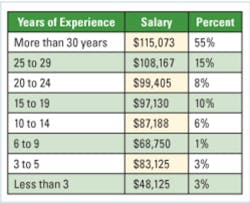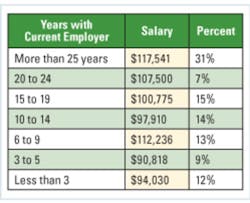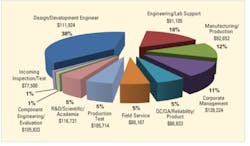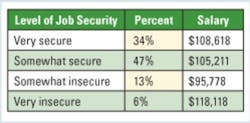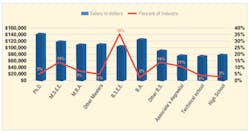Salaries of EE-Evaluation Engineering readers continue to creep up, reaching an average of $106,800 this year, up from $103,240 last year.1 According to our 2015 salary survey responses, a majority at 66% report receiving a raise over the last year, with only 4% indicating a decrease in salary. Of course, benefits are part of the compensation package, and more than 94% of respondents receive health insurance through their jobs, with 84% receiving dental insurance. Majorities report taking advantage of a 401k or pension plan and life insurance.
Childcare remains a rare benefit in our industry—it’s available to less than 8% of respondents. One who wished to remain anonymous commented, “Employer-sponsored child care and paid maternity/paternity leave are very important issues not being addressed.”
Unsurprisingly, salary increases with years of experience (Figure 1). The relationship is less clear with regard to years with current employer (Figure 2). Those who have been with their current employer the longest do indeed earn the highest salaries, but those with six to nine years experience with their current employer do slightly better than those who have held on slightly longer.
Salary also increases with age—up to a point. Respondents in the 56 to 65 bracket earned an average of $114,564, but those 66 and older were paid an average of $106,112. The survey didn’t specifically ask whether all the respondents over 65 were continuing to work full time, but Mark Willette at IBM volunteered that he would like to see some help in the transition from a full-time to a part-time position in retirement, either with the same company or a different company. “Some of us old veterans in the industry probably would love to be able to help out a young startup company,” he said. Then again, a startup might not always be a good fit. An anonymous respondent commented, “Getting ready to retire, one more year—this is a young company still going through growing pains.” He is, however, “just glad I’m here.”
When asked to choose three key career issues that are important to them, 61% of respondents cited salary and work-life balance, 50% noted job security, and 12% selected the related issue of outsourcing. Other issues cited included education and retraining (39%), technical obsolescence (28%), and ethics (26%).
One anonymous respondent with a particular interest in education and training would have checked all the listed issues had the survey design not limited responses to three. “Nothing in our engineering/technical/scientific realm is standing still. Everything is moving forward at ever-increasing speed; no company can afford to not train their employees. A football team, basketball team, baseball team is expected to practice and continuously improve its skills, but not so in the corporate world, so companies fall behind.”
Company culture also is an issue. One respondent commented, “During recent years, the company has instituted the GE 10-80-10 plan and changed from a family-oriented culture of taking care of each other to a competitive culture where you better watch your back. The company also has established a policy of only hiring new college graduates for engineering positions. Having experience is an immediate disqualifier for employment.” Another added, “Different companies’ cultures usually are a reflection of the management style within the organization—some are very supportive of a work-life balance; however, others are all about the bottom line regardless of the impact on the workforce.”
Location, location, function
Where you are and what you do will influence your earning potential. As for location, the Pacific region is the place to be if you are looking for a high salary, followed by the Northeast (Figure 3). As for job function, managers do the best with regard to salary (Figure 4), although respondent John Howard of RSI Inc. reported not wanting to focus exclusively on management tasks. “It would seem I have reached the point in my career where most employers value me more for my management capabilities even though I feel I have a lot more to offer technically,” he said.
After managers, those involved in academic and scientific research and development earn the highest salaries. Design and development engineers come in third while those involved in incoming test and inspection bring up the bottom. As for industry, those in wireline and fiber-optic communications score the highest average salaries (Figure 5). Those involved in semiconductors and components, software, and energy all earn above $120,000 on average.
A large majority of respondents feel somewhat or very secure in their jobs (Figure 6); only 6% report feeling very insecure. Many respondents, however, volunteered that they are concerned about the H1-B visa program and outsourcing. One commented, “Companies still think they can save money building everything in China even though we have to rework everything to fix all the issues.”
Age is also an issue that can lead to insecurity. One anonymous respondent commented, “The company, in general, is replacing older and senior engineers by new graduates or young engineers with a few years of experience—and thus pays a lot less … and reduces the overhead for biding on a contract.”
As for formal education, you can earn more on the job by earning a Ph.D. (Figure 7). Surprisingly, respondents claiming a B.A. came in second in this ranking, although they represented only a 2% sample. That anomaly aside, those holding an M.S.E.E. did well, followed by those with masters’ degrees in business administration or other fields.Figure 7. Salary vs. education
One respondent had a specific complaint about formal education—having to take political courses to learn thermodynamics. “The accredited educational system has to get out of politics. Education has become a government-sponsored business; each is feeding off the other, pretending to know what’s best for gaining knowledge,” this respondent said, adding that educational programs from organizations like “… SAE, ASM, IEEE, and ASTM actually provide technical direction, and they do not spew political views—they stick to the subject.”
Building skills
Apart from formal educational programs that lead to a degree, respondents pursue a variety of strategies for maintaining their skills. More than 40% report reading trade publications and their websites, with a similar percentage taking advantage of webcasts and online events sponsored by a company or professional organization. 35% attended in-person training sessions provided by a vendor, and 24% attended trade shows. 11% attended online classes run by a university, and just fewer than 10% have attended on-campus university classes. Several volunteered that they make use of on-the-job training and find Internet search to be a valuable tool. Just under a quarter of respondents report not having taken advantage of such training—a figure that’s down from 37% last year.
As was the case last year, more than half of those responding to the survey use mobile devices on the job, with the Android smartphone at 31% maintaining its position as the most popular platform, followed by the iPhone at 27%. iPad and Android tablets also find use, with the iPad at 14% edging out Android tablets at 13%. 4% of respondents use BlackBerry, down from 7% last year.
Satisfaction despite concerns
Survey respondents do have many complaints and concerns. Said one who wished to remain anonymous, “The current company CEO is a megalomaniac micromanager. If you see him, run the other direction. Enough said.” Added another, “I have few/no concerns as an employee because I own the company. I have many concerns with the economy as a whole and the deterioration of the workforce, suppliers, and customers.”
Adds yet another, “My dissatisfaction with my career is mostly centered around my employer’s habits of making us feel insecure, making irrational demands, pushing for unpaid OT at all times, never forgetting an oversight, and constantly badgering about meeting schedules” but refusing to approve projects until the last minute.
Nevertheless, respondents overall report high degrees of job satisfaction (Figure 8). Only 14% indicate being somewhat or very dissatisfied.
Reference
Nelson, R., “Engineering wages show slow improvement,” EE-Evaluation Engineering, August 2014, p. 20.

